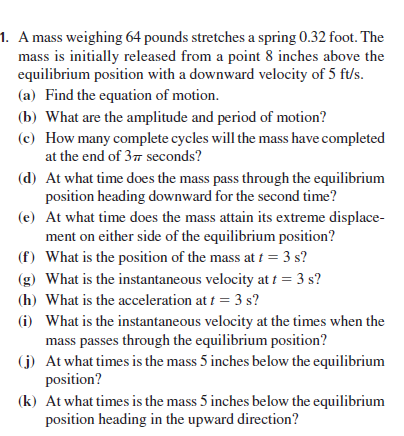1. A mass weighing 64 pounds stretches a spring 0.32 foot. The mass is initially released from a point 8 inches above the equilibrium position with a downward velocity of 5 ft/s. (a) Find the equation of motion. (b) What are the amplitude and period of motion? (c) How many complete cycles will the mass have completed at the end of 37 seconds?
1. A mass weighing 64 pounds stretches a spring 0.32 foot. The mass is initially released from a point 8 inches above the equilibrium position with a downward velocity of 5 ft/s. (a) Find the equation of motion. (b) What are the amplitude and period of motion? (c) How many complete cycles will the mass have completed at the end of 37 seconds?
Related questions
Question
Hi can you help me whith thant problem?
see image

Transcribed Image Text:1. A mass weighing 64 pounds stretches a spring 0.32 foot. The
mass is initially released from a point 8 inches above the
equilibrium position with a downward velocity of 5 ft/s.
(a) Find the equation of motion.
(b) What are the amplitude and period of motion?
(c) How many complete cycles will the mass have completed
at the end of 37 seconds?
(d) At what time does the mass pass through the equilibrium
position heading downward for the second time?
(e) At what time does the mass attain its extreme displace-
ment on either side of the equilibrium position?
(f) What is the position of the mass at t = 3 s?
(g) What is the instantaneous velocity at t = 3 s?
(h) What is the acceleration at f = 3 s?
(i) What is the instantaneous velocity at the times when the
mass passes through the equilibrium position?
(j) At what times is the mass 5 inches below the equilibrium
position?
(k) At what times is the mass 5 inches below the equilibrium
position heading in the upward direction?
Expert Solution
This question has been solved!
Explore an expertly crafted, step-by-step solution for a thorough understanding of key concepts.
This is a popular solution!
Trending now
This is a popular solution!
Step by step
Solved in 4 steps
